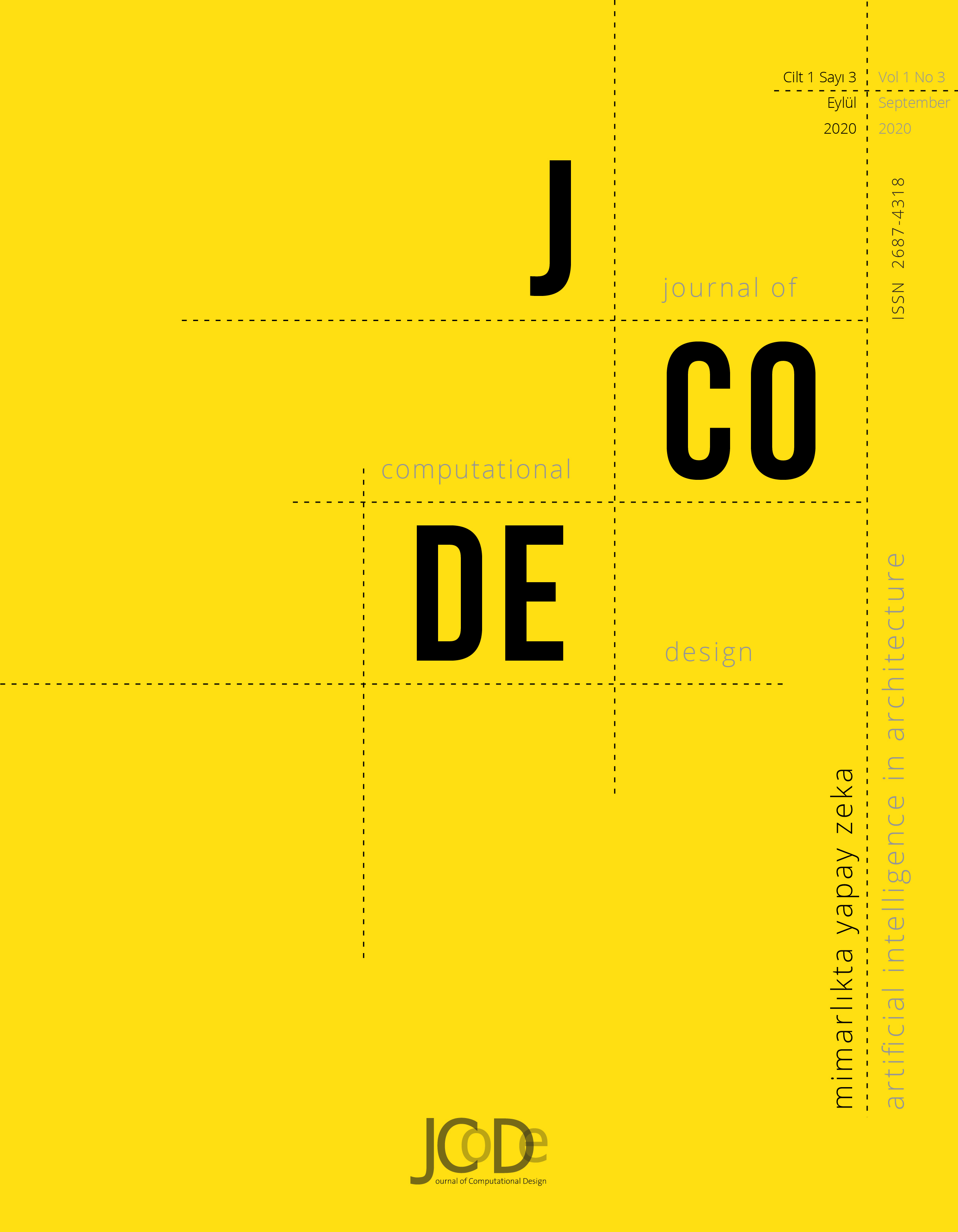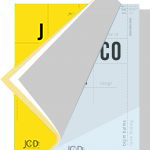Cover
1. Cover
Page I
Editorial
2. Artificial Intelligence in Arhitecture
Gülen Çağdaş, Sema Alaçam, Ethem Gürer
Page V
Articles
3. Computational Design Informed by Natural Systems
Sevil Yazıcı
Page 1-17
Yazici, S. (2020). Computational Design Informed by Natural Systems. JCoDe: Journal of Computational Design, 1(3), 1-17.
https://dergipark.org.tr/tr/download/article-file/1254359
ABSTRACT
Animate and inanimate matters in nature are evaluated within systems’ unity. Natural systems represent order and balance defined by computation. Mathematicians, biologists, material scientists and professionals from other fields investigate natural systems for problem-solving. Although nature has been used as a reference since historical periods, there are improper uses on how to integrate nature efficiently into the design process. The term biomimicry is used today by transcending its meaning from imitating nature towards learning from its intelligence. There is a necessity that architectural design students develop their skills on computation and evaluate natural systems from an analytical point of view to apply their finding in creative design solutions. This research is about an elective course on biomimicry developed for undergraduate architectural design education. The methodology consists of three stages, including investigation of the natural systems (1), the abstraction of the natural systems and extracting the system parameters (2), implementing the parameters in the computational design model (3). The proposed study was implemented from 2018 to 2020 into the student projects, of which outputs are discussed and grouped under four categories, including organization-, performance-, process- and motion-based computation. By examining the results, it is determined that the students gained skills in computational design and their awareness related to the natural systems were increased.
Keywords: Natural Systems, Computation, Algorithms, Architectural Design Education.
4. Evaluation of Metro Lines with Swarm Intelligence Approach
Sena Kaynarkaya, Gülen Çağdaş
Page 17-48
Kaynarkaya, S., Çağdaş, G. (2020). Evaluation of Metro Lines with Swarm Intelligence Approach. JCoDe: Journal of Computational Design, 1(3), 17- 48.
ABSTRACT
Computer technologies have an important place in the fields of architecture and urban design as in every field today. It is possible to see that they are largely inspired by the life cycles of living organisms, when we look closely at the development processes of these technologies in the fields of architecture and urban design.
Slime mould which are examples of emerging living systems; shows an example of swarm intelligence, which arises from basic needs and produces results very different from individual behavior. Rail systems that significantly reduce the burden of today's urban transportation networks, are constantly changing and renewed, especially in large cities. When we look at the examples of which slime mould are used, it is seen that they have a very important role in the design of metro lines and highway systems.
In the article, it is aimed to evaluate an existing metro line by modeling slime mould behaviors with swarm intelligence approach in digital environment. Based on the studies conducted to evaluate the conformity of the metro lines and highways design criteria, this study will work on the Göztepe-Ümraniye metro line in Istanbul, which is still under construction. The stations on the line were kept constant and the model was expected to create a route, and the compliance of the route with the metro design criteria was evaluated. At points that do not comply with the design criteria, commands are introduced on the model via Python code, and the similarities and differences between the route
created by the swarm and the existing route are compared.
Keywords: Swarm Intelligence, Slime Mould, Railway Design.
5. A Decision Support System Proposal for the Optimization of Traffic on the Bosphorus Line: E-Bosphorus
Esranur Demirtaş, Şehnaz Cenani
Page 49-70
Demirtaş, E., Cenani, Ş. (2020). Boğaz Hattındaki Trafiğin Optimizasyonuna Yönelik Bir Karar Destek Sistemi Önerisi: E-Bosphorus. JCoDe: Journal of Computational Design, 1(3), 49- 70.
ABSTRACT
The Bosphorus Line, one of the important regions of Istanbul, is faced with problems such as traffic congestion and noise pollution caused by this problem in the recreation areas on this line. The main reason for these problems is the intensity of transportation by individual vehicles. However, the traffic density on this line can be reduced as a result of the fact that public transportation is provided by sea transportation, which is a characteristic mode of transportation in Istanbul inner city transportation, which is exactly parallel to this route, and is preferred for reasons such as comfort, speed and price. The inefficient use of sea transport depending on factors such as route planning and expedition times poses a problem in choosing this type of transportation. Considering the available possibilities, it is possible to optimize the road traffic on the bosphorus line by encouraging individuals using sea transportation as a result of the smart synchronization of the routes and the time schedules connected to these routes. Therefore, it is aimed to show a way to make a better regulation by revealing the shortcomings of the current (maritime) traffic regulation. It is aimed to develop the conceptual framework of a decision support system that regulates maritime traffic and the benefits of the proposed system are stated. Decision tree and shortest path finding algorithms are used as methods in the study. In addition to the shortest path problem, finding the shortest time is one of the criteria discussed in this study. As a result, the shortest route and the routes to be reached in the shortest time were determined when going from a pier on the bosphorus line to another one. In addition, the interface design of an application (E-Bosphorus) has been developed to make the current bosphorus line ferry timetables more efficient
Keywords: Intelligent Seaborne Transportation, Bosphorus Line, Decision Support System, Route Finding.
6. Regenerating Modern Interiors into Science Fiction Environments via Cycle-GAN
Esra Yağdır Çeliker, Gizem Efendioğlu, Özgün Balaban
Page 71-94
Yağdır, E., Efendioğlu, G., Balaban, Ö. (2020). Cycle-GAN ile Modern İç Mekanlarının Bilim Kurgu Ortamları Olarak Yeniden Üretilmesi. JCoDe: Journal of Computational Design, 1(3), 71-94.
ABSTRACT
Deep learning is a machine learning method that uses artificial neural networks for complex tasks and problems that require the processing of large data sets. Deep learning has shown that it is possible to process the properties of the data that previously needed to be transferred to the computer by an expert person, only by a computer. Generative Adversarial Networks (GAN) algorithm, one of the subsystems of deep learning, takes advantage of the contention of two neural networks working opposite each other. While the Generator produces fake images, the Discriminator evaluates the images and generates the information that the image is fake or real. This contentious situation between two networks repeats until the Discriminator cannot distinguish the image is fake. For this reason, researchers prefer to use the GAN especially in image processing and image translation problems. With the image processing techniques offered by deep learning, it is possible to process complex spatial data and to reproduce spatial fictions through images. The study aims to investigate the new spatial potentials of interior spaces with different characteristics. In this context, modern interiors are reinterpreted as distopic science fiction spaces by using the GAN algorithm, which is a suitable technique for image processing. In this study, we created two different data sets from modern interior photographs and science fiction movies. Thus, we tried to investigate how modern interiors can change morphologically when they become a part of science fiction movies.
Keywords: Cycle-GAN, Deep Learning, Machine Learning, Spatial Image Processing, Artificial İntelligence in Architecture.
7. Map Generation & Manipulation with Generative Adversarial Networks
Ozan Balcı, Şemsi Barış Terzi, Özgün Balaban
Page 95-114
Balcı, O., Terzi, B. Ş., Balaban, Ö. (2020). Çekişmeli Üretici Ağlar ile Harita Üretimi ve Manipülasyonu. JCoDe: Journal of Computational Design, 1(3), 95-114.
ABSTRACT
Artificial intelligence makes the Big Data processable as the spread of the Internet. Machine learning, which is a type of artificial intelligence, has made it easier to classify, interpret and process data. On the other hand, the development of graphics processing units has facilitated and accelerated the work done by providing the necessary infrastructure for processing data consisting of images. The development of image processing operation will enable the processing and production of architectural data sets consisting of images. This study aims to show the processability of the image set in map scale and to encourage to think and examine how the achievements in this process can be processed in different scales. In accordance with this purpose, satellite images and map images of a game are handled as data using a GAN model.The model, which is trained with satellite and game maps images contain different textures of nature, different types of transportation networks, settlements of different densities and qualities, can perform two-way transformations (game map from satellite image and satellite image from game map).The study focused on the generation of game maps from satellite images, and during the process, tests for the generation of game maps from satellite images of different locations around the world and analyzes based on these tests were conducted. As the last step of the study, to obtain the most successful results, the model inputs were optimized with the findings obtained from the analyzes and by using satellite images of these regions, the game maps of ‘Istanbul Historical Peninsula’ and ‘Istanbul Göksu’ regions were produced.
Keywords: Generative Adversarial Networks, Machine Learning, Map Generation.
8. Classification of Historic Ornaments with CNN
Sevgi Altun, Cem Güneş
Page 115-131
Altun, S., Güneş, C. (2020). Evrişimsel Sinir Ağları Kullanarak Anadolu Selçuklu Desenlerinin Sınıflandırılması. JCoDe: Journal of Computational Design, 1(3), 115-131.
ABSTRACT
This paper is a critical assessment of an exploration of computer vision and deep learning methods in an architectural heritage context. Convolutional neural network, a type of deep learning is implemented to classify a group of Anatolian Seljuk ornamental patterns. The field of computer vision offers the potentials to assist studies in the field of architectural heritage. However, there are limited studies that combine knowledge across the two fields. One frequently studied topic is image classification based on features. In this study, we took on the task of classifying Anatolian Seljuk ornamental patterns to investigate the potential. The project focused on carved ornamental patterns on flat surfaces due to ease of data collection. The group of images is collected and arranged as two different yet related datasets. The classes are floral and geometrical, and subclasses are sparse and dense for both. Two different CNN architectures are used to train models for predictions. The process and effect of dataset creation on the implementation are explained. Results are discussed from both the technical and architectural points of view, providing a basis for further interdisciplinary studies.
Keywords: Convolutional Neural Networks, Architectural Ornaments, Anatolian Seljuk Ornaments, Architectural Heritage, Artificial Intelligence
9. Oyunlaştırmanın Kişisel Veri Toplanmasına Etkisi
Tolga Bilbey, Tahir Sandıkkaya
Page 131-152
Bilbey, T., Sandıkkaya, M. T. (2020). Oyunlaştırmanın Kişisel Veri Toplanmasına Etkisi. JCoDe: Journal of Computational Design, 1(3), 131-152.
ABSTRACT
Oyunlaştırma, kişilerin gelişigüzel görevleri tamamlamasını güdülemekte kullanılır. İnternet altyapısının doksanlı yılların başında ticarileşmesiyle birlikte reklâm gelirleri ile bu altyapı fonlandı. Böylece küresel reklâm şirketleri, hedef kitleye daha iyi odaklanmak ve karlılığı artırmak için olabildiğince çok kişisel veri toplamayı hedeflediler. Bu amaçla uyumlu olarak, reklâm şirketlerinin İnternet üzerinden küresel çapta kullanmaya başlamalarıyla oyunlaştırmaya ilgi artmıştır. Bu yaklaşım kişilerin İnternet'i kullanmayı sürdürmek için özlük bilgilerinin gizliliğinden ödün vermesi gerektiği tartışmasını ortaya çıkarmaktadır. Bu çalışma oyunlaştırmanın kişisel veri toplanmasına etkisinin gösterilmesini amaçlar. Etkiler, oyunlaştırılmış bir ortamda yürütülen bir anketle ölçülmüştür. Kişilerin beyanları ve demografik bilgileri, davranışları ile örtüştürülerek gözlenmiştir. Çalışmanın ortaya koyduğu en dikkat çekici sonuç; kişiler farkına varmadan davranışlarının değiştirilebileceğidir. Bu durumda, oyunlaştırma uygulamalarını sürdüren kişilerin etik değerlerle çelişmemek için son derece dikkatli olmaları gerekir.
Keywords: Oyunlaştırma, Özlük Bilgilerinin Gizliliği, Anket.
10. Yapay Zeka Çırakları İnsan Emsallerinden Daha İyi Performans Gösterirse?
Lale Başarır
Page 153-166
Başarır, L. (2020). Yapay Zeka Çırakları İnsan Emsallerinden Daha İyi Performans Gösterirse? JCoDe: Journal of Computational Design, 1(3), 151-166.
ABSTRACT
Bu çalışmanın odak noktası, mimarinin bilgi tabanı bir yapay zekaya teslim edildiğinde bilgisayar destekli mimarinin artık yapay zeka destekli mimariye (AIAA) nasıl dönüşebileceğine dair bir vizyon çizmektir. Bu nedenle böyle bir mimarinin vizyonu, insanın evriminin çağlarına uygun olarak tasvir edilmiştir. Bu nedenle, mimarlığın örtük bilgisi, veri / bilgi / bilgi birikimi ve bilgelik hiyerarşisi ile bağlantılı olarak incelenmektedir. Bu nedenle, AI uygulamalarının mevcut durumunu ve olası geleceğini tanımlama bağlamında, Yapay Dar Zekâ (YDZ)I, Yapay Genel Zekâ (YGZ) ve Yapay Süper Zekâ (YSZ)olarak kavramsal seviyeleri okuyucuya tanıtılmaktadır. Dar yapay zeka uygulamaları, farklı alanlarda birbirinden bağımsız olarak çalışılmaktadır. Bu çalışma, bilgi çağında mimarlığın tüm bilgisini öğrenen ve daha sonra kendisini bilgelik çağında YGZ'ye bağlayan varsayımsal bir mimar yapay zekayı okuyucuya sunulmaktadır. Mimarların, gelecekteki çıraklarını en iyi ve özelleştirilmiş mekanları yaratma uygulamaları için eğitmek istiyorlarsa üstlenmeleri gereken, kullanıcı odaklı yaklaşıma vurgu yapılmaktadır. Bu bağlamda, yapay zeka ile üretilen çıktıların, hala “tasarım” olarak kabul edilip edilemeyeği tartışılmaktadır.
Keywords: Yapay Zeka, Yapay Genel Zeka, Yapay Zeka Destekli Mimar, Mimarlık Bilgisi, Kullanıcı Odaklı Tasarım
11. GAN ile Mimari Plan Üretimlerinin Değerlendirilmesi Üzerine Bir Durum Çalışması
Can Uzun
Page 167-182
Uzun, C. (2020). GAN ile Mimari Plan Üretimlerinin Değerlendirilmesi Üzerine Bir Durum Çalışması. JCoDe: Journal of Computational Design, 1(3), 167-182.
ABSTRACT
Bu çalışma GAN algoritması çıktılarının değerlendirildiği yöntemlerin değerlendirilmesi üzerine bir çalışma niteliğindedir. GAN çıktısı değerlendirme yöntemleri her nekadar literatürde kabul görmüş olsa da mimari plan şemalarından oluşan bir veri seti eğitim çıktılarında da GAN verimliliğinin aynı değerlendirme yöntemleri ile kullanılıp kullanılmaması cevaplanması gereken bir soru halindedir. Bu çalışma boyunca GAN algoritmasının alt sınıfında bulunan DCGAN algoritması ile üretilmiş Palladyan plan şemalarının ve GAN algoritmasının verimliliği değerlendilirmiştir. Bu değerlendirme yapılırken GAN algoritmasının literatürde kabul görmüş nicel ve nitel değerlendirme yöntemlerinden sırasıylsa Frechet Inception Distance ve hızlı sahne sınıflandırması kullanılmıştır. Değerlendirme sonucunda bu yöntemlerin mimari plan üretimi için uygunluğu tartışılmıştır. Metnin sonnda nicel ve nitel GAN değerlendirme yöntemlerinin mimari plan şeması üretimlerini değerlendirmek üzere özelleşmiş yeni yöntemlere ihtiyacı olduğu sonucuna varılmıştır.
Keywords: GAN Değerlendirme, Frechet Inception Distance, Hızlı Sahne Sınıflandırması.
©2023 Journal of Computational Design & The Rectorate of Istanbul Technical University. All rights reserved.
Your continued use of this site signifies that you accept the terms of use.

The papers published in JCoDe are licensed under a Creative Commons Attribution-NonCommercial 4.0 International License.
Istanbul Technical University | Faculty of Architecture




